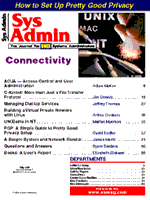
Editor's Forum
Today, connectivity, and the administrative effort needed to provide it, is largely taken for granted by users. Internet and Web access have become commonplace, and users expect to be able to perform various types of business-related research online at acceptable speeds. System administrators at large, well-funded sites often provide these capabilities with big-ticket hardware from major network vendors such as 3Com, Cisco, and Hewlett Packard. Remote access is no longer a matter of having a few modems that provide dial-in capability to character-based applications. Now, full network access is provided to remote users at such sites with chassis-based modem pools with scores of ports. Meanwhile, smaller sites may still use standalone modems attached directly to a system dedicated to communications services. Or, access might be provided through relatively inexpensive terminal servers from companies such as Lantronix and Specialix, which focus on the smaller end of the market. The enabling factor in all of these systems is the ability of the connectivity hardware to support multiple protocols across a range of connection types and at speeds that are consistent with the requirements of graphical interfaces. UNIX connectivity continues to be a key issue within heterogeneous environments and will be for years to come. Frequently, it is these connectivity features of UNIX that bind different systems into a productive organization-wide system architecture. Users want features from different platforms to seamlessly work together, and it is often UNIX that provides that capability. The challenge for the system administrator is to anticipate user needs far enough in advance that infrastructure elements can be put in place before the user demand gets out of control. Internally, this often means improving the bandwidth of the network with switched, rather than shared, Ethernet. Network backbones and server connections likely need to be at 100 Mbps or beyond, providing fat pipes to 10/100 Ethernet switches at the departmental level. Externally, connectivity planning probably includes improvements in remote access capabilities - more, and higher speed, connections for mobile users and even customers that may be part of an extranet. To assist you in these efforts, upcoming issues Sys Admin will be examining various areas of technology that you have indicated are high on your plan-to-purchase priority list. Although the product focus sections, such as the one that debuted last month, will be the center of our efforts, you will also see a sprinkling of articles that are connectivity-related throughout the calendar. Our Web theme in August and the Networking theme in October are good examples. While "being connected" once meant doing business with nefarious, underworld types, it has now become the unspoken mantra of modern society. Email me from your cellular PDA, and we'll do coffee.
Sincerely yours,
|